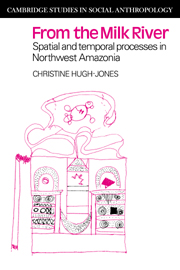Book contents
- Frontmatter
- Contents
- List of figures, tables and maps
- List of myths
- Preface
- Acknowledgements
- Orthography
- 1 Introduction
- 2 Social structure
- 3 The set of specialist roles
- 4 Kinship and marriage
- 5 The life-cycle
- 6 Production and consumption
- 7 Concepts of space–time
- 8 Conclusion
- Appendix 1 Named groups
- Appendix 2 Kinship terminology
- Works cited
- Index
- CAMBRIDGE STUDIES IN SOCIAL ANTHROPOLOGY
6 - Production and consumption
Published online by Cambridge University Press: 07 October 2009
- Frontmatter
- Contents
- List of figures, tables and maps
- List of myths
- Preface
- Acknowledgements
- Orthography
- 1 Introduction
- 2 Social structure
- 3 The set of specialist roles
- 4 Kinship and marriage
- 5 The life-cycle
- 6 Production and consumption
- 7 Concepts of space–time
- 8 Conclusion
- Appendix 1 Named groups
- Appendix 2 Kinship terminology
- Works cited
- Index
- CAMBRIDGE STUDIES IN SOCIAL ANTHROPOLOGY
Summary
Introduction
It is the very same people who produce and consume on the one hand and who grow, experience ritual change, marry, reproduce and die on the other: Pirá-paraná Indians make the most of this fact.
In this chapter, we shall see that the processes of producing and consuming various substances are analogous to the processes of reproducing both individuals and the social structure. The relations between the individuals who make up Pirá-paraná society are ordered through production and consumption in the daily routine and on ritual occasions. In promoting these ordered relations, socio-economic processes play a positive part in social reproduction. We saw that when individuals absorb substances, they also absorb the processes, whether mythical, shamanic or practical, which contribute to the production of these substances: here, the same argument is extended to the ‘relations of production’ and also to the relations between natural species (as conceived of in Indian ideology).
I must warn the reader that the ordering of this chapter is rather complex. Because the same substances appear in different contexts, the analysis is built up on many different fronts from one part to the next. Throughout, the conclusions about production and consumption are used to further the analysis of the life-cycle begun in the previous chapter.
For subsistence purposes, the longhouse group is a virtually self-sufficient unit. It is divided in two principal ways – into family units or ‘family productive units’, and by sex.
- Type
- Chapter
- Information
- Publisher: Cambridge University PressPrint publication year: 1980

